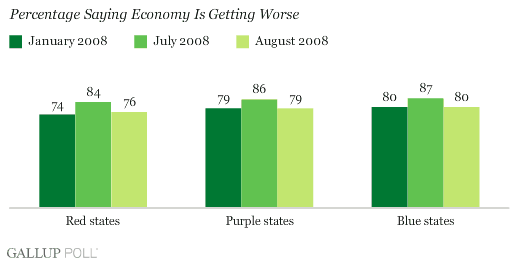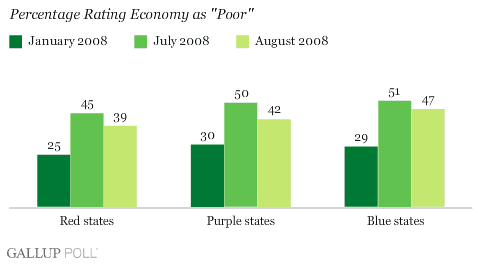PRINCETON, NJ -- Consumer pessimism moderated in August in the key battleground or "purple" states, as well as in "red" and "blue" states. The percentage of consumers saying the economy is "getting worse" declined by 7 to 8 points from July in each of these groupings of states, and now essentially matches where things were in January.

Consumer Pessimism Moderating Across the Political Landscape
On Tuesday, the Conference Board surprised many economists by announcing that consumer confidence improved more than economists had anticipated during August. As , consumer pessimism has moderated in response to the decline in gas prices since mid-July. Significantly, this easing in the degree of consumer pessimism has taken place across the political landscape.
As the percentage of consumers saying the economy is getting worse has declined in the purple, red, and blue states since July, so has the percentage rating the economy "poor." In the battleground states, the percentage of consumers rating the economy "poor" fell to 42% in August from 50% in July, but remains significantly higher than the 30% who provided this rating in January. Although consumers in red states are least likely -- and those in the blue states are most likely -- to rate the economy as poor, once again, the overall pattern is essentially the same as the "getting worse" ratings: the August numbers for all three state groups show a decrease from July (though they are up from January's readings).

Commentary
On Wednesday, the Commerce Department reported that the U.S. economy grew at a 3.3% annual rate during the second quarter -- far above the 1.9% originally estimated, and largely the result of stronger U.S. exports creating a smaller trade deficit. This was in addition to a surprisingly good durables goods report the same day. Add in the increase in consumer confidence, and the bulls on Wall Street began to repeat their assertions that the U.S. economy isn't really that bad.
Before the Republicans jump on this bandwagon politically, they would do well to consider consumers' views of the economy, particularly in the battleground states. The percentage of purple-state consumers thinking the economy is getting worse may be down 7 percentage points from July, but even after this improvement, essentially 8 in 10 consumers in those states are pessimistic about the direction of the economy.
Even more importantly, a similar decline of 8 points in the number of consumers rating the economy "poor" in the battleground states leaves 42% of purple-state consumers giving this rating -- 12 points higher than the 30% who held this view in January. And, while a higher percentage of blue-state consumers (47%) give the economy poor ratings, even in the red states, 39% of consumers share this view.
With a Republican in the White House, the party and its presidential candidate may be tempted to use the recent rays of sunshine in the economic data to argue that wise international free-trade policies are keeping the U.S. economy much stronger than is generally perceived. And, of course, voter perceptions of the economy may improve even more between now and November. But, as George H.W. Bush's campaign learned in 1992, there can be problems with such an approach. Even if McCain ends up being prescient by saying the economy has turned a corner and is getting better, he risks appearing out of touch with Main Street if his campaign attempts to paint too rosy an economic picture even as the overwhelming majority of Americans still believe the economy is getting worse.
In politics as well as economics, perceptions are often reality. In this case, the reality is that most battleground consumers continue to see the economy going in the wrong direction and are looking for leadership to alter that course. For McCain's sake, they had better not perceive that "he doesn't get it."
Survey Methods
║┌┴¤═° is interviewing no fewer than 1,000 U.S. adults nationwide each day during 2008. The economic questions analyzed in this report are asked of a random half-sample of respondents each day. The results reported here are based on combined data of more than 8,000 interviews in January, July, and August. For results based on these samples, the maximum margin of sampling error is ┬▒1 percentage point. The margins of error for subgroups are higher.
Interviews are conducted with respondents on land-line telephones (for respondents with a land-line telephone) and cellular phones (for respondents who are cell-phone only).
In addition to sampling error, question wording and practical difficulties in conducting surveys can introduce error or bias into the findings of public opinion polls.
To provide feedback or suggestions about how to improve ║┌┴¤═°.com, please e-mail feedback@gallup.com.
